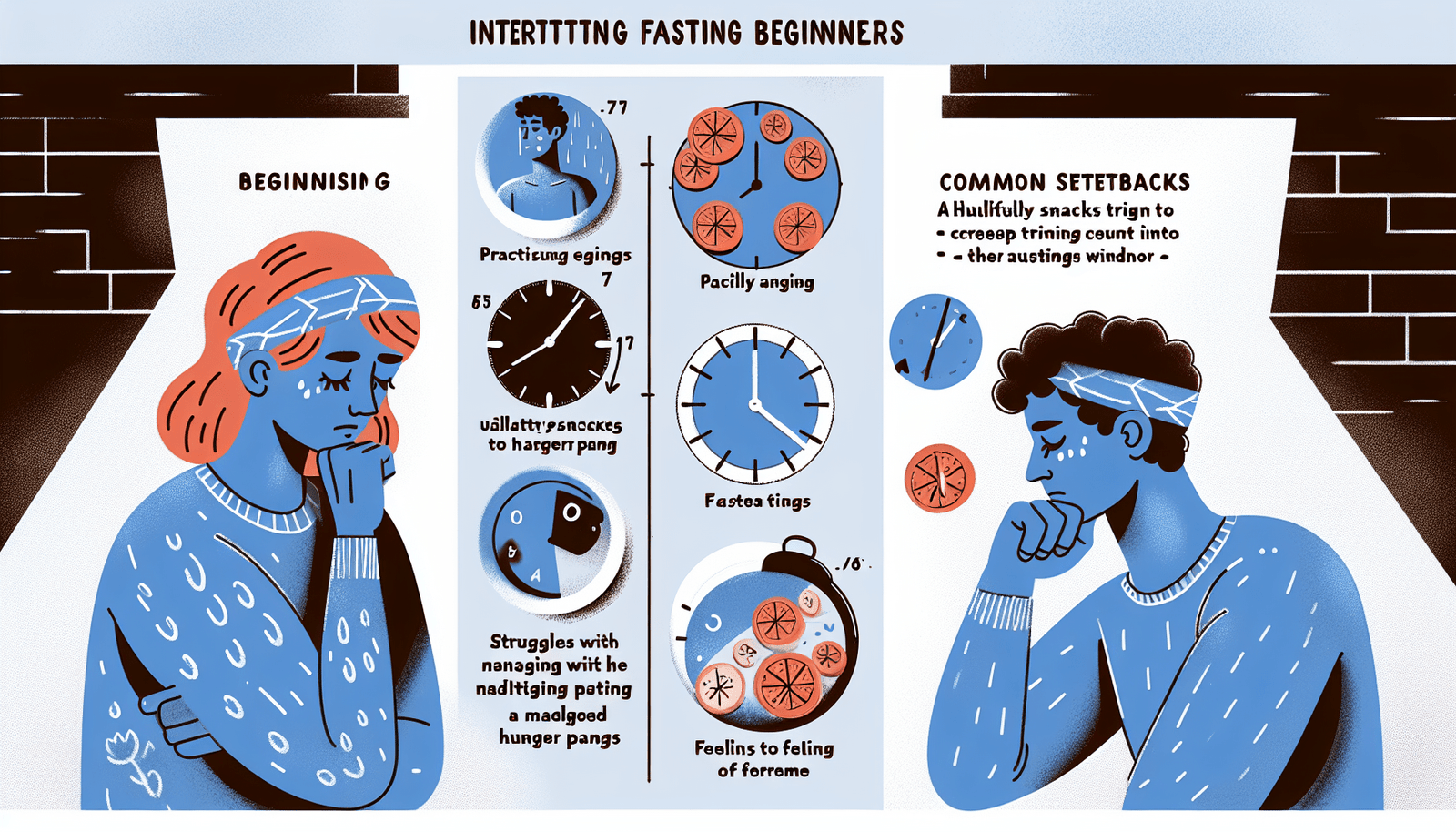So you’ve finally decided to give intermittent fasting a try, but you’re quickly realizing that it’s not as easy as it may seem. Don’t worry, you’re not alone. Many beginners face common challenges and setbacks when starting out with intermittent fasting. Whether it’s dealing with hunger pangs, lack of energy, or even struggling with sticking to your fasting window, this beginner’s guide is here to help you troubleshoot these issues so you can achieve your fasting goals. Let’s dive in and discover some practical tips and strategies to overcome the hurdles that may come your way on your intermittent fasting journey.
Understanding Intermittent Fasting
Intermittent fasting has gained popularity in recent years as a way to improve health and promote weight loss. But what exactly is intermittent fasting? In simple terms, it is a eating pattern that involves alternating periods of fasting and eating. Unlike traditional diets that focus on what you eat, intermittent fasting focuses on when you eat.
What is Intermittent Fasting?
Intermittent fasting involves cycling between periods of fasting and eating. During the fasting periods, you consume little to no calories, while during the eating periods, you can eat normally. There are several different methods of intermittent fasting, but the most common ones include the 16/8 method, the 5:2 diet, and alternate-day fasting.
The 16/8 method involves fasting for 16 hours and eating within an 8-hour window each day. For example, you might choose to skip breakfast and start eating at noon, then finish your meals by 8 PM. The 5:2 diet involves eating normally for 5 days of the week, and restricting calories to 500-600 for the remaining 2 days. Alternate-day fasting, as the name suggests, involves fasting every other day, with some variations allowing for a limited calorie intake on fasting days.
Benefits of Intermittent Fasting
Intermittent fasting offers numerous benefits beyond just weight loss. Some of the potential benefits include improved insulin sensitivity, better brain health, increased energy levels, reduced inflammation, and enhanced autophagy, which is the body’s process of cleaning out damaged cells. Studies have also shown that intermittent fasting may help improve heart health, reduce the risk of chronic diseases, and increase longevity.
Different Types of Intermittent Fasting As mentioned earlier, there are several different methods of intermittent fasting. Each method has its own unique approach and suits different lifestyles and preferences. The 16/8 method is one of the most popular and easiest to follow, as it simply involves extending the overnight fast and skipping breakfast. The 5:2 diet allows for more flexibility, as you can choose which days of the week to restrict calories. Alternate-day fasting requires more discipline, as you are fasting every other day. It’s important to choose a method that fits your lifestyle and is sustainable for you in the long run.
Setting Realistic Goals
Setting goals is an important aspect of any journey, including intermittent fasting. By setting clear and realistic goals, you can stay motivated and track your progress. Without goals, it’s easy to lose focus and give up when faced with challenges or setbacks.
Why Setting Goals is Important
Setting goals gives you a sense of purpose and direction. It helps you stay committed to your intermittent fasting journey and provides motivation to keep going. Having a clear goal in mind also allows you to track your progress and make adjustments when necessary. Without goals, it’s easy to lose sight of why you started and give in to temptation or distractions.
Determining Your Goals
When determining your goals, it’s important to be specific, measurable, achievable, relevant, and time-bound – also known as S.M.A.R.T. goal setting. Be specific about what you want to achieve with intermittent fasting, whether it’s weight loss, improved health markers, or increased energy levels. Make sure your goals are measurable so that you can track your progress. Be realistic and set achievable goals that are within your reach. Your goals should also be relevant to your overall well-being and aligned with your values. Lastly, set a timeline for achieving your goals to create a sense of urgency and keep yourself accountable.
S.M.A.R.T. Goal Setting
To implement S.M.A.R.T goal setting, let’s say your goal is to lose 10 pounds in the next 3 months through intermittent fasting. This goal is specific (10 pounds), measurable, achievable, relevant to weight loss, and time-bound (3 months). By breaking down your ultimate goal into smaller, actionable steps, you can create a roadmap to success.
For example, you can set a weekly weight loss target of 1-2 pounds, adjust your fasting window to align with your lifestyle, incorporate regular exercise, and focus on nourishing your body with whole, nutrient-dense foods. By setting S.M.A.R.T goals, you can stay motivated, track your progress, and overcome challenges along the way.

Dealing with Hunger Pangs
Hunger pangs are a common challenge when starting intermittent fasting, especially during the initial adjustment period. Understanding the reasons behind hunger pangs and implementing effective strategies can help you manage them and stay on track with your fasting regimen.
Understanding Hunger Pangs
Hunger pangs are typically a result of a hormonal response triggered by an empty stomach. When we don’t eat for a certain period of time, our body releases ghrelin, the hunger hormone, which signals to our brain that it’s time to eat. This can lead to feelings of hunger and discomfort.
Strategies to Manage Hunger Pangs
Fortunately, there are several strategies you can try to manage hunger pangs during your fasting period. Firstly, staying well-hydrated can help reduce hunger pangs, as dehydration can sometimes be mistaken for hunger. Drink plenty of water throughout the day, and consider incorporating herbal tea or black coffee, as they can also help suppress appetite. Consuming foods that are high in fiber and protein during your eating window can increase satiety and keep you feeling full for longer. Additionally, practicing mindful eating and being aware of your body’s hunger cues can help distinguish between true hunger and emotional cravings.
Adjusting Your Fasting Window
If hunger pangs persist even after implementing these strategies, it may be worth adjusting your fasting window. Experiment with different fasting schedules and find the one that works best for your body and lifestyle. You can gradually increase or decrease the length of your fasting period until you find a balance that minimizes hunger pangs while still providing the desired benefits of intermittent fasting. Remember, it’s important to find a fasting schedule that is sustainable and enjoyable for you in the long term.
Managing Fatigue and Low Energy
Fatigue and low energy levels can sometimes be experienced during intermittent fasting, especially in the initial stages. It’s important to understand the potential causes and take proactive steps to combat these challenges.
Causes of Fatigue During Intermittent Fasting
One common cause of fatigue during intermittent fasting is an inadequate calorie intake. When you restrict your eating window or reduce your calorie intake, your body may not be receiving enough fuel to sustain your energy levels. Additionally, fluctuations in blood sugar levels can also contribute to feelings of low energy. During fasting periods, your body relies on stored glycogen for energy, and if those stores are depleted, it can lead to fatigue.
Tips to Combat Fatigue
To combat fatigue during intermittent fasting, it’s crucial to prioritize proper nutrition. Make sure you are consuming enough calories and macronutrients during your eating window to support your energy needs. Focus on nutrient-dense foods such as whole grains, lean proteins, fruits, and vegetables. Including healthy fats like avocado or nuts can also provide sustained energy throughout the day.
Managing stress levels, getting enough quality sleep, and practicing stress-relieving techniques like meditation or yoga can also contribute to improved overall energy levels. Regular exercise can help boost energy and improve stamina, but be cautious not to overexert yourself during fasting periods.
Importance of Proper Nutrition
Proper nutrition plays a key role in managing fatigue and maintaining optimal energy levels during intermittent fasting. When planning your meals, be mindful of the quality and quantity of food you consume. Ensure your meals are well-balanced and provide sufficient calories to meet your body’s needs. Adequate hydration is also important, as dehydration can further exacerbate feelings of fatigue. By focusing on nourishing your body with nutrient-rich foods and staying hydrated, you can combat fatigue and maintain higher energy levels throughout your intermittent fasting journey.

Overcoming Plateaus
Plateaus, where weight loss or other desired outcomes stall, can be frustrating during intermittent fasting. However, with the right strategies, plateaus can be overcome, and progress can be resumed.
What are Plateaus in Intermittent Fasting?
Plateaus refer to periods where progress seems to come to a halt, whether it’s in terms of weight loss or other desired outcomes such as improved energy levels or reduced inflammation. These plateaus can occur due to various reasons, including metabolic adaptation, hormonal fluctuations, or even physiological and psychological factors.
Strategies to Break Plateaus
To break plateaus during intermittent fasting, it’s important to make adjustments to your approach. Firstly, consider reviewing your calorie intake and macronutrient distribution. Evaluate whether you may have unintentionally increased your calorie consumption or skewed your macronutrient balance. Tracking your food intake and using a food diary or mobile app can help identify any potential discrepancies.
In addition to monitoring your calorie intake, incorporating regular exercise can help boost metabolism and break through plateaus. Strength training, in particular, can help build lean muscle mass, which enhances metabolism even when at rest. Varying your workout routine and adding intensity can also challenge your body and prevent it from adapting to a specific exercise regimen.
Importance of Exercise
Exercise is not only beneficial for weight loss but can also have a positive impact on overall health and well-being. In combination with intermittent fasting, exercise can amplify the benefits and help overcome plateaus. Aim for a mix of cardiovascular exercise and strength training, focusing on movements that you enjoy and that align with your fitness level.
Keep in mind that breaking through plateaus requires patience and perseverance. Stay consistent with your intermittent fasting schedule, track your progress, and make adjustments when necessary. By staying committed and incorporating regular exercise, you can overcome plateaus and continue progressing towards your goals.
Handling Cravings and Food Temptations
Cravings and food temptations are a common challenge faced during intermittent fasting. Learning to understand and manage these cravings is essential for success.
Understanding Cravings and Temptations
Cravings and food temptations can arise due to both physiological and psychological factors. Physiologically, certain foods can trigger pleasurable responses in the brain, leading to cravings. Psychologically, factors such as stress, emotions, or habit can also contribute to cravings and temptations. It’s important to distinguish between true hunger and cravings and find strategies to address them effectively.
Ways to Curb Cravings
One effective way to curb cravings during intermittent fasting is to ensure you are consuming a balanced diet during your eating window. Include foods that are high in fiber, protein, and healthy fats, as they can help keep you feeling satisfied and reduce cravings. Avoid highly processed and sugary foods, as they can lead to blood sugar imbalances and subsequent cravings.
Practicing mindfulness and being aware of your emotions and triggers can also help curb cravings. Stay engaged in activities that distract you from food, such as taking a walk, reading a book, or spending time with loved ones. Delaying gratification by telling yourself that you can have the food you’re craving later, during your eating window, can also be an effective strategy.
Healthy Alternatives for Tempting Foods
When cravings strike, having healthy alternatives readily available can help satisfy your taste buds without derailing your intermittent fasting efforts. Opt for nutrient-dense snacks such as nuts, Greek yogurt, or whole fruits. If you’re craving something sweet, try indulging in a piece of dark chocolate or a small portion of natural sweeteners like fresh berries or dates. Experiment with different flavors and textures to find healthy alternatives that satisfy your cravings without compromising your goals.
Dealing with Social Situations
Intermittent fasting can present challenges when it comes to social situations and gatherings involving food. It’s important to have strategies in place to navigate these situations while staying true to your intermittent fasting regimen.
Challenges of Intermittent Fasting in Social Gatherings
Social gatherings often revolve around food and can be challenging for those following intermittent fasting. Family events, parties, or outings to restaurants can tempt you to break your fast or indulge in unhealthy food choices. Social pressure and the fear of missing out can also make it difficult to stick to your fasting schedule.
Strategies to Navigate Social Situations
To navigate social situations while practicing intermittent fasting, it’s important to plan ahead. Communicate your goals and dietary preferences with your close friends and family members. By explaining the benefits of intermittent fasting and how it aligns with your overall health goals, you can enlist their support and understanding. It’s also helpful to educate yourself about the menu or food options available at the social gathering or restaurant beforehand. This way, you can make informed decisions and select food items that align with your fasting window and dietary preferences.
If necessary, consider adjusting your fasting window or modifying your eating schedule to accommodate social events. For example, if you have a dinner invitation during your fasting period, you can shift your eating window to later in the day or plan a shorter fasting period on that particular day. Remember that intermittent fasting is flexible, and occasional adjustments can be made to ensure a sustainable approach.
Educating and Communicating with Others
Educating and communicating with others about intermittent fasting can help create a supportive environment. Share information with friends and family members, and use these opportunities to clarify any misunderstandings or misconceptions. By openly discussing your goals and the benefits of intermittent fasting, you can foster understanding and reduce external pressure to deviate from your fasting plan.
Remember, it’s important to maintain a healthy balance between your intermittent fasting routine and social life. Intermittent fasting is not meant to hinder your enjoyment of social events, but rather to provide a framework for overall well-being. By planning ahead, adjusting when necessary, and communicating your goals, you can successfully navigate social situations while staying committed to intermittent fasting.
Addressing Digestive Issues
Digestive issues can sometimes arise during intermittent fasting, posing a challenge to your overall well-being. Understanding common digestive issues and implementing tips for better digestion can help alleviate discomfort and enhance your fasting experience.
Common Digestive Issues during Intermittent Fasting
Intermittent fasting can sometimes disrupt the body’s digestive processes, leading to common issues such as bloating, constipation, or acid reflux. These issues can arise due to changes in eating patterns, dehydration, or an inadequate intake of dietary fiber.
Tips for Better Digestion
To promote better digestion during intermittent fasting, it’s important to prioritize hydration. Aim to drink plenty of water throughout the day, as staying well-hydrated can help prevent constipation and support bowel regularity. You can also incorporate herbal teas or warm lemon water to soothe the digestive system.
Increasing your fiber intake can also help alleviate digestive issues. Focus on consuming fiber-rich foods such as fruits, vegetables, and whole grains during your eating window. Fiber helps promote regular bowel movements and supports a healthy gut microbiome. Consider incorporating fermented foods like sauerkraut or yogurt, as they can also aid digestion.
Lastly, manage stress levels as heightened stress can aggravate digestive issues. Practice stress-relieving techniques such as deep breathing, meditation, or gentle exercise like yoga. Creating a calm and relaxed environment during meal times can also promote better digestion.
Foods to Include and Avoid
To support better digestion during intermittent fasting, include foods that are gentle on the digestive system. Opt for easily digestible foods such as cooked vegetables, lean proteins, and whole grains. Incorporate probiotic-rich foods like yogurt or kefir to promote a healthy gut microbiome. Consuming natural digestive aids like ginger or peppermint tea can also provide relief from digestive discomfort.
Conversely, it’s important to avoid trigger foods that can exacerbate digestive issues. Highly acidic or spicy foods, carbonated beverages, and processed foods can irritate the digestive system. Identify any specific food intolerances or sensitivities you may have and avoid them during your eating window to minimize digestive distress.
By prioritizing hydration, incorporating fiber-rich foods, and maintaining a calm and stress-free environment, you can address common digestive issues and optimize your intermittent fasting experience.
Tracking Progress and Making Adjustments
Tracking your progress is crucial for staying motivated and making adjustments when necessary. By monitoring your weight, measurements, and other relevant markers, you can assess your progress and make informed decisions to optimize your intermittent fasting journey.
Importance of Tracking Progress
Tracking your progress during intermittent fasting allows you to objectively assess the impact of your efforts. It provides you with valuable information about how your body is responding to the fasting protocol and helps you identify patterns or trends that may influence your results. By keeping track of your progress, you can stay motivated, celebrate milestones, and make adjustments when needed.
Monitoring Weight and Measurements
One of the most common ways to track progress is by monitoring your weight and taking measurements. Weighing yourself regularly, such as once a week, is a simple way to determine if you’re losing weight. However, it’s important to remember that weight is just one metric and doesn’t always reflect changes in body composition. Taking measurements of your waist, hips, and other areas of interest can provide a more comprehensive overview of your progress.
In addition to weight and measurements, consider tracking other markers that are relevant to your goals. This could include body fat percentage, blood pressure, cholesterol levels, or even subjective measures such as energy levels or mood. Keeping a journal or using a tracking app can help you visualize and analyze your progress over time.
Making Adjustments when Necessary
As you track your progress, you may notice patterns or trends that require adjustments to your intermittent fasting routine. For example, if you’ve reached a weight loss plateau or are experiencing excessive fatigue, it may be time to reevaluate your calorie intake or fasting schedule. Similarly, if you’re not seeing the desired results, you might need to review your food choices or exercise routine.
When making adjustments, it’s important to do so gradually and systematically. Intermittent fasting is a lifestyle, not a quick fix, and making sustainable changes is key to long-term success. Experiment with different approaches, monitor how your body responds, and make modifications as needed.
By tracking your progress and making adjustments when necessary, you can continuously optimize your intermittent fasting journey and work towards achieving your goals.
Maintaining Long-Term Success
Maintaining long-term success with intermittent fasting requires consistency, developing healthy habits, and seeking support and accountability. By adhering to these principles, you can create a sustainable and rewarding lifestyle.
The Importance of Consistency
Consistency is the backbone of intermittent fasting. It’s important to adhere to your chosen fasting schedule and eating window to see long-term results. Consistency helps your body adjust to the fasting regimen and allows for physiological adaptations to occur. By consistently practicing intermittent fasting, you can establish a routine that becomes second nature and maximizes the benefits.
Developing Healthy Habits
Intermittent fasting is not just about when you eat, but also about adopting healthy lifestyle habits. Focus on nourishing your body with whole, nutrient-dense foods during your eating window. Prioritize regular exercise and engage in activities that you enjoy and that promote overall well-being. Get enough quality sleep, manage stress levels, and practice mindful eating. By incorporating these habits into your daily routine, you can support your intermittent fasting journey and increase your chances of long-term success.
Seeking Support and Accountability
Finding support and accountability can significantly enhance your intermittent fasting experience. Join online communities or local groups that share your interest in intermittent fasting. Surround yourself with like-minded individuals who can provide motivation, share experiences, and offer guidance. Consider sharing your intermittent fasting journey with a trusted friend or family member who can serve as an accountability partner. By having someone to share your challenges and successes with, you can stay motivated and accountable to your goals.
Remember, intermittent fasting is a tool that can help you achieve your health and wellness goals. It’s important to make it a part of your lifestyle and embrace the journey. By maintaining consistency, developing healthy habits, and seeking support and accountability, you can achieve long-term success with intermittent fasting.








